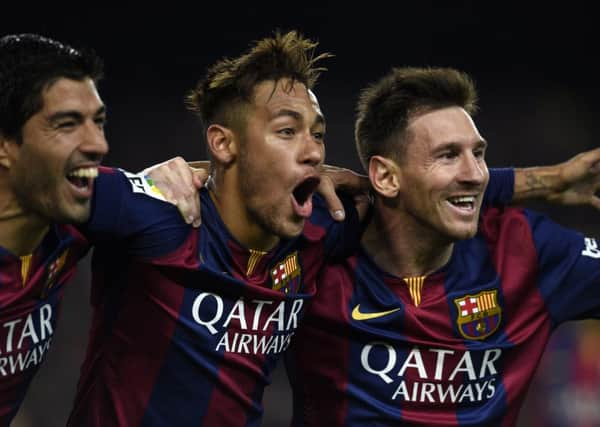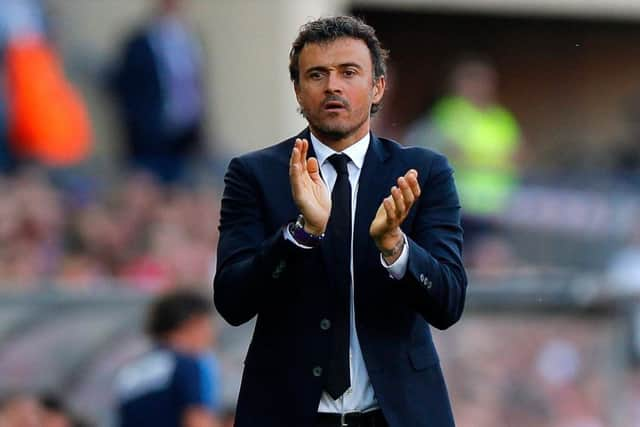Jonathan Wilson: Barca’s Three amigos are clicking


IT’S a lesson Real Madrid keep on failing to learn, but having the best players doesn’t necessarily mean you have the best team. For much of the first half of the season, Barcelona seemed to have gone down a similar route to their arch-rivals and seemed to be facing similar problems. Over the past four months, though, their situations have been transformed and, next Saturday, they could win their third Champions League in six years, confirming their status as the pre-eminent team of the age. But this is not the same Barça: while many of the personnel remain the same as in those past triumphs, they have found this season a new way of playing. The jadedness of familiarity is gone and what has emerged in its place is a less avant garde, more flexible team.
At the turn of the year, Barça had three star forwards in Lionel Messi, Luis Suarez and Neymar, all of them capable of doing something brilliant, but there was no great cohesion among them. They still beat most teams – good players will do that – but at the winter break nobody had any doubt that this wasn’t really enough: it wasn’t enough to win the Champions League, and it wasn’t enough to justify the deviation from recent Barcelona tradition in starting to sign celebrities.
Advertisement
Hide AdAdvertisement
Hide AdThe issue of the Barcelona tradition is a vexed one. Under Pep Guardiola, the club made a great virtue of its La Masia academy and the way it was living out through its youth policy the philosophy of Rinus Michels and Johan Cruyff, conveniently ignoring the intervening 30 years or so when they relied on imported talents such as Ronaldo, Rivaldo, Diego Maradona and Steve Archibald. Signing Neymar and Luis Suarez was a step away from the purity of the homegrown ideal that Guardiola had taken to extremes. For a club that prided itself on being “mes que un club” and had revelled in the sense of itself as an organic model set against the off-the-shelf superstars of Real Madrid, there needed to be some pay-off.


In January, Barcelona appeared to be in crisis. Luis Enrique, below, had left Lionel Messi on the bench for the first game after the winter break, which was lost 1-0, to Real Sociedad. Messi had sat out the equivalent game in the previous two seasons, but suddenly it became an issue as he skipped training with “gastroenteritis”. Perhaps he really was suffering stomach problems, but it was unfortunate that Xavi had revealed the previous week that “gastroenteritis” was the excuse commonly used when a player had other reasons for skipping training.
Messi, it was assumed, was in all-out revolt against Enrique. That was only part of it. The club were being investigated over alleged irregularities in the signing of Neymar and were operating under a transfer ban for failing to follow the correct procedures in signing youth players. The afternoon Messi missed training, former keeper Andoni Zubizarreta was sacked as sporting director. His assistant, the former captain Carles Puyol, left the club the following day. Luis Enrique was left isolated, all the more so when the defender Jeremy Mathieu admitted that Messi and his coach had clashed on the training pitch.
Winning, though, disguises a multitude of flaws. The Barça president, Josep Bartomeu, and the former president, Sandro Rosell, are still facing charges over the Neymar deal, but the sense of crisis has eased. Since beating Atletico Madrid 3-1 the week after the Sociedad defeat, Barça have grown in confidence and stature. They’ve won the league and reached the Champions League final.
Most significantly, the front three have found a way of playing together.
Perhaps a certain early season unease was only to be expected: Messi, despite being named player of the tournament, had had a miserable World Cup; Neymar had suffered fractured vertebrae and seen his nation hammered 7-1 by Germany; and Suarez had been banned for biting Giorgio Chiellini.
When Suarez returned to the side in October, he started out playing wide on the right with Messi central. In the spring they switched: Suarez suggests that Messi made the decision during a game rather than it being a predetermined plan from Luis Enrique, but whoever was responsible, the new configuration works.
The three-man forward line, though, has changed how Barça play, as has Xavi’s acceptance of a place on the bench as age overcomes him and his replacement by Ivan Rakitic.
Advertisement
Hide AdAdvertisement
Hide AdOf the ten outfielders likely to start the final against Juventus, seven played against Bayern when Barça were embarrassingly hammered in the Champions League semi-final in 2012 under Tito Vilanova, but this is a much more direct team.
Towards the end of Guardiola’s time at the club, there was a perceptible slackening in Barça’s pressing, as though the players could no longer maintain the same intensity. That has carried on: this season, through tackles and interceptions, Messi, Neymar and Suarez have regained the ball between them on average 3.2 times per game.
Three years ago, Messi, Alexis Sanchez and Pedro regained it 5.1 times per game. The forwards aren’t absolved of defensive responsibility, but they focus more on the attacking side of the game than they did.
That Rakitic instinctively looks for a forward pass, even if it risks losing possession – rather than operating, as Xavi did, in sideways circumlocutions – enhances the process. Barça now are as much about dribbling and counter-attacking as they are about holding possession.
What sets them apart is that they can play both proactive and reactive football.
Perhaps that means that this Barça is not quite such a pure incarnation of the Michels-Cruyff ideal as Guardiola’s model, but it probably doesn’t make quite such demands – physical and mental – on players. Guardiola’s side was one of the all-time great teams, the beautiful and successful manifestation of an ideal. Luis Enrique’s side isn’t that, but it might prove an extremely successful evolution of the team Guardiola left.
PAST GLORIES
BARCELONA
1992: Barcelona 1 Sampdoria 0
After living in the shadow of Real Madrid’s European Cup record, Barça finally got their hands on the trophy. Ronald Koeman’s free-kick won the final at Wembley.
2006: Barcelona 2 Arsenal 1
With 14 minutes remaining, Barcelona were trailing to Sol Campbell’s opener in Paris. Substitute Henrik Larsson turned the game for Barça, setting up late goals for Samuel Eto’o and Juliano Belletti.
2009: Barcelona 2 Manchester United 0
Advertisement
Hide AdAdvertisement
Hide AdEto’o and Lionel Messi scored to earn Barça a historic treble of La Liga, Copa del Rey and Champions League.
2011: Barcelona 3 Manchester United 1
Pedro’s opener was cancelled out by a Wayne Rooney equaliser but Barça powered ahead in the second half with goals by Messi and David Villa at Wembley.
JUVENTUS
1985: Juventus 1 Liverpool 0
The game was a sideshow as 39 Juventus supporters died when a wall collapsed inside Heysel Stadium in Brussels. Juve won with a Michel Platini penalty.
1996: Juventus 1 Ajax 1 (Juve won 4-2 on pens)
Eleven years after Heysel, Fabrizio Ravanelli opened the scoring for Juve. Jari Litmanen equalised for holders Ajax but the Turin side won in a penalty shoot-out.